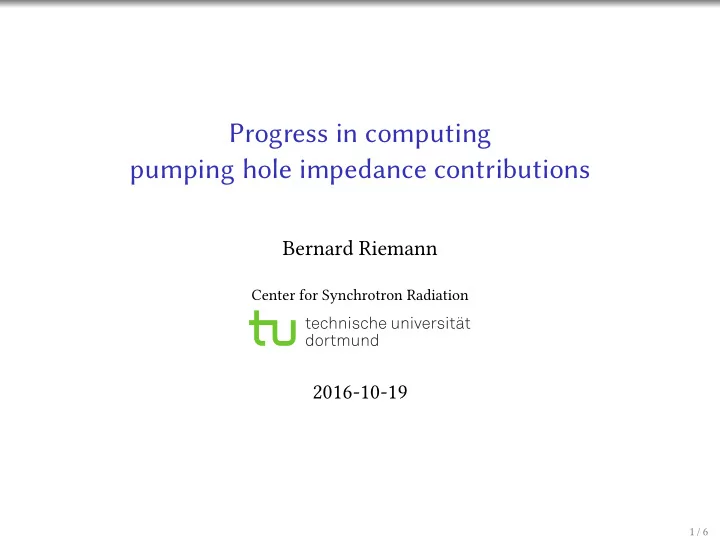

Progress in computing pumping hole impedance contributions Bernard Riemann Center for Synchrotron Radiation 2016-10-19 1 / 6
Methods of impedance computation Pumping holes are rather difficult to compute directly using FEM/FIT due to their small relative size (although it is possible, e.g. [3]). Instead, holes can be treated as perturbations, represented by elementary dipoles For frequencies below cutoff, the problem can be further reduced to an electrostatic problem, following the approach described in [1, 2]. Longitudinal hole impedance (below cutoff, see [1]) ω c ( α el + α mag ) e 2 Z ( ω, 0 , 0 ) = − i Z 0 r ( 0 ) α el , mag polarization constants defined by hole geometry e r ( 0 ) normalized electric field produced at the hole position by a line charge ar � r = 0. ( ⇒ simulation) 2 / 6
Input for e r ( 0 ) simulations Design Mesh As we have no access to the design sketches, the model parameters had to be extracted (as far as possible) from previous presentations. Te larger semiaxis of the inner pipe ellipse had to be modeled by eye. For comparison, the impedance of a circular pipe with R = 19 mm was also computed numerically (although this is a simple analytical expression). Simulation is performed using COMSOL [4]. 3 / 6
Preliminary results liner FCC e 0 r / m − 1 Z / Z ref ∝ e 2 hole angle / ◦ Setup r ( 0 ) 19mm circular (ana.) 8 . 3766 1 1 − 5 × 10 − 5 19mm circular [4] 8 . 3764 13mm circular (ana.) 12 . 243 2.136 liner sketch [4] ≈ 70 12 . 922 2.380 8 . 5 × 10 − 3 FCC sketch [4] 0 (horizontal) 0 . 770 72 8 . 39 × 10 − 9 < 10 − 10 45 (diagonal) 4 / 6
Summary Preliminary results are promising, indicating that hiding the pumping holes behind the screen decreases the low-frequency impedance at least by two orders of magnitude. Possible next steps: Update design sketches with accurate geometry data, compute absolute low-frequency impedances using computations from [5, 6]. 5 / 6
References Tanks to everyone for their contribution! [1] S.S. Kurennoy, IHEP 92-84 technical report (1992) [2] S.S. Kurennoy, Part. Acc. 39 , pp. 1–13 (1992) [3] M. Takao et al., ”Estimation of the Longitudinal Impedance of the ATF Dampng Ring”, Proc. PAC1991 (1991) [4] COMSOL Multiphysics 5.2, COMSOL, http://www.comsol.com/ [5] A. Mostacci, ”Beam-Wall interaction in the LHC liner”, Ph.D. thesis (University of Rome, 2001) [6] A. Mostacci and F. Ruggiero, ”Pumping slots and thickness of the LHC beam screen”, LHC Project Note 195 (1999) 6 / 6
Recommend
More recommend